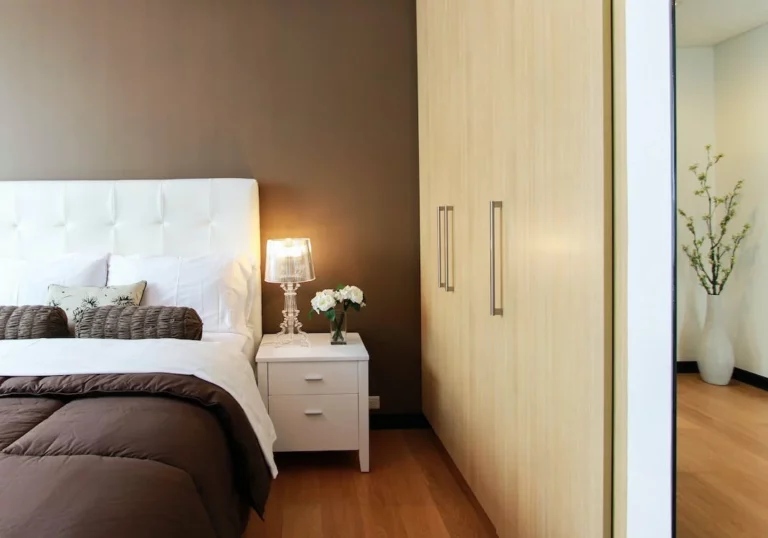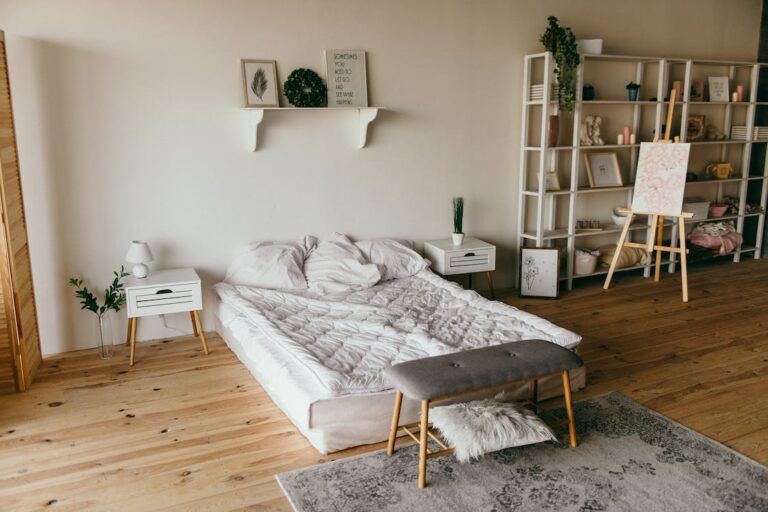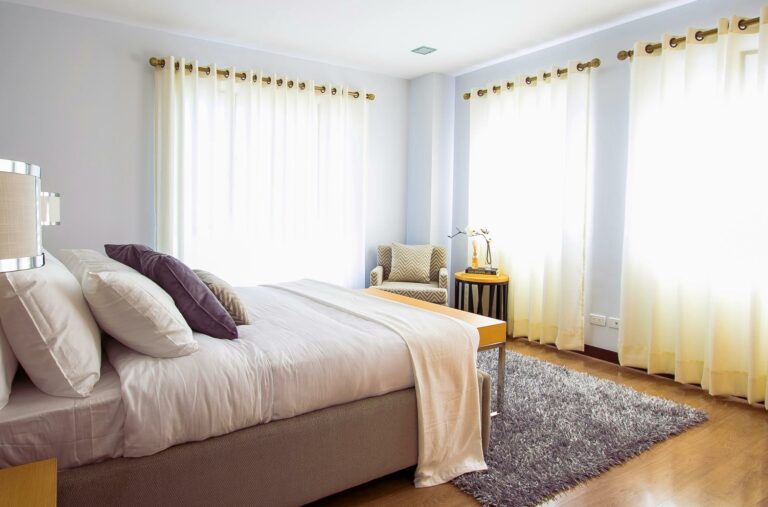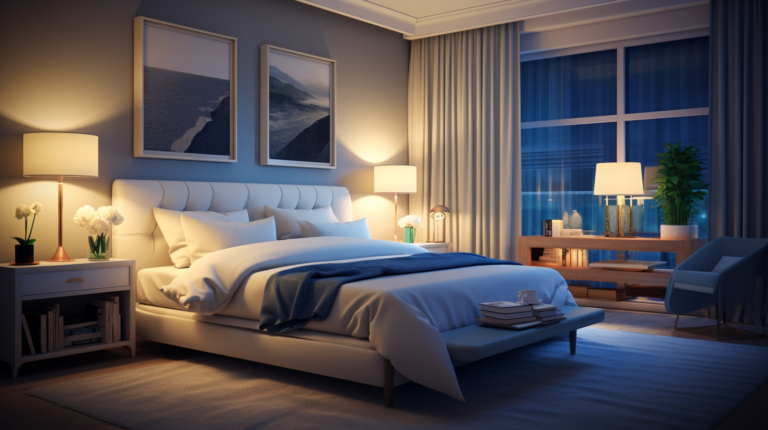Elevate Your Bedroom Design with Unique Accent Wall Ideas
Are you looking to give your bedroom a fresh new look? One of the easiest ways to elevate your bedroom design is by incorporating an accent wall. An accent wall is a single wall in a room that is designed to stand out and create a focal point. Whether you want to add a pop of color, create a bold statement, or bring in an element of texture, accent walls offer endless possibilities for transforming your bedroom.
In this article, we will explore the impact that accent walls can have on your bedroom design and share various ideas to inspire you. We’ll also discuss how to choose the right paint or material for your accent wall and provide step-by-step guidance on creating one yourself. If you’re not so DIY-inclined, we’ve got you covered too – we’ll touch on the benefits of seeking professional assistance for your accent wall design.
So, if you’re ready to take your bedroom to the next level, let’s dive into the world of accent walls and discover how they can breathe new life into your space.
Table of Contents
Bedroom Design with Unique Accent Wall Ideas
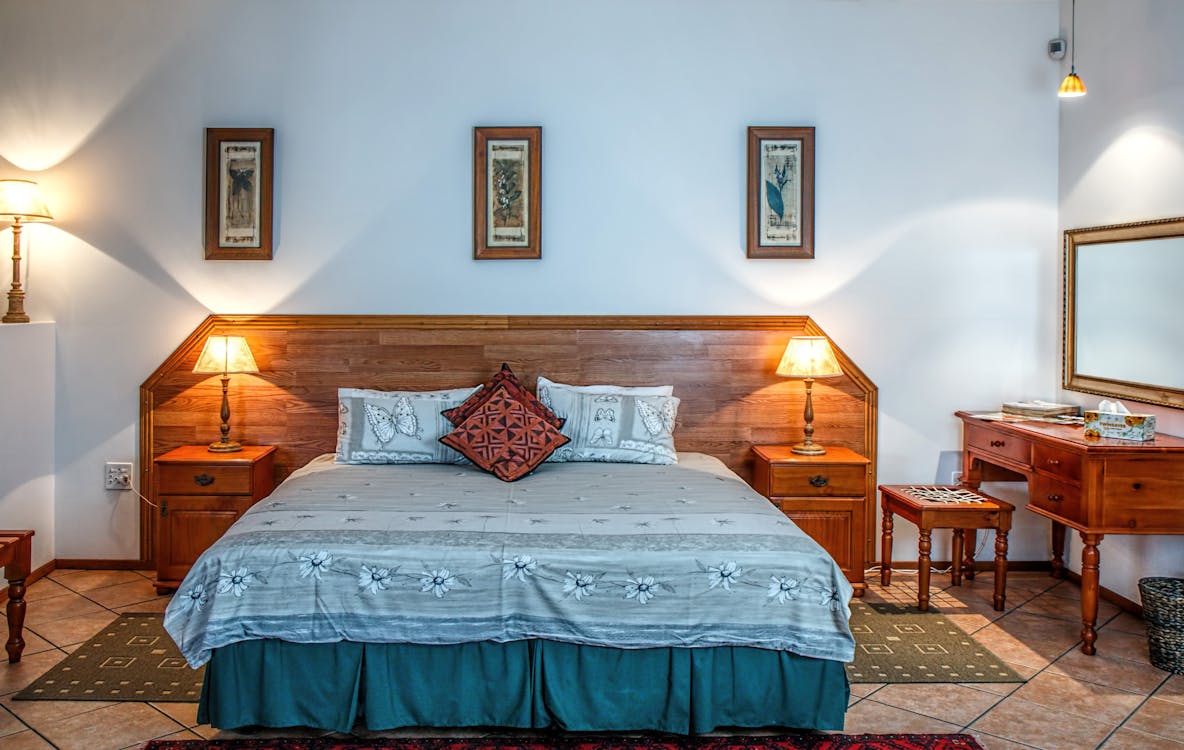
When it comes to home decor, accent walls have a transformative power that can instantly revitalize a space. With a simple coat of paint or a bold wallpaper choice, these walls become the focal point of a room, adding depth, character, and a touch of personality. Let’s explore the impact of accent walls and how they can reflect your unique style and taste.
Transformative Power
Accent walls have the ability to completely transform the look and feel of a room. By featuring a different color, texture, or pattern than the surrounding walls, they create visual interest and draw the eye to a specific area. This can be especially beneficial in rooms that lack architectural elements or have plain, monotonous walls.
With the right choice of color or design, an accent wall can evoke a specific mood or set the tone for the entire space. For example, a vibrant red accent wall can infuse a room with energy and passion, while a serene blue or green accent wall can create a more calming and inviting atmosphere. Whether you want to make a bold statement or create a cozy corner, an accent wall allows you to achieve it with ease.
Personality Reflection
One of the significant advantages of accent walls is their ability to reflect your personality and style. They provide an opportunity to showcase your creativity and individuality in a space that might otherwise be too uniform. By incorporating colors or patterns that resonate with you, your accent wall becomes a personalized expression of who you are.
Here are a few ways in which accent walls can reflect your personality:
- Bold and Adventurous: If you have a fearless and adventurous spirit, consider a vibrant and eye-catching accent wall in a daring color like electric orange or deep purple.
- Minimalistic and Modern: For those who prefer a more understated and contemporary look, a simple accent wall in a neutral color like gray or beige can exude a sleek and minimalistic vibe.
- Nature Lover: If you’re drawn to the beauty of the outdoors, consider an accent wall with a nature-inspired wallpaper featuring floral, botanical, or landscape motifs.
- Artistic and Eclectic: Showcase your artistic flair by opting for an accent wall adorned with a unique mural, abstract design, or even a gallery-like arrangement of framed artworks.
Remember, the key is to choose an accent wall design that resonates with your personal style and complements the overall aesthetic of the room. It should be an extension of your taste and preferences, creating a space that feels uniquely yours.
In conclusion, accent walls are more than just a decorative element; they have the power to transform a room, add personality, and reflect your individual style. Whether you opt for a bold color, a captivating pattern, or a striking wallpaper, accent walls can be a game-changer in your home decor. So don’t be afraid to experiment and let your creativity shine through these focal points of design.
Various Accent Wall Ideas

One of the best ways to add a pop of personality and style to any room is by creating an accent wall. An accent wall can completely transform the look and feel of a space, giving it a unique and eye-catching focal point. Whether you prefer subtle, understated designs or bold, vibrant colors, there are endless possibilities for accent walls.
Geometric Patterns
Geometric patterns are a popular choice for accent walls and can add a modern and sleek touch to any room. Here are a few ideas to consider:
- Herringbone: This classic pattern creates a sense of movement and adds depth to a space. It works well in living rooms, bedrooms, or even home offices.
- Hexagons: Hexagon-shaped tiles or wallpaper can create a striking visual effect. Use a monochromatic color palette for a sophisticated look or go bold with vibrant hues for a more playful vibe.
- Diamonds: Diamond-shaped patterns can add a touch of elegance and charm to any room. Consider using metallic paints or wallpapers to enhance the luxurious feel.
Bold Colors
If you’re not afraid to make a statement, a bold colored accent wall might be just what you need. Here are some ideas to consider:
- Bright Red: Red is a powerful color that can add drama and energy to a space. It works well in living rooms, dining rooms, or even kitchens.
- Navy Blue: Navy blue is a versatile and timeless color that can create a calming and sophisticated atmosphere. It’s perfect for bedrooms or home offices.
- Emerald Green: Green is associated with nature and can bring a sense of tranquility to a space. Consider using emerald green for a tropical or botanical-inspired accent wall.
Mural Designs
If you want to make a bold statement or create a visual centerpiece in a room, a mural design might be the perfect choice. Here are a few ideas to consider:
- Landscape: A landscape mural can bring the outdoors inside and create a sense of tranquility. Consider a beach scene for a relaxing coastal vibe or a mountain landscape for a serene and peaceful atmosphere.
- Cityscape: Bring the city to your home with a cityscape mural. Whether you choose a vibrant and bustling city or a serene nighttime cityscape, it can add a touch of urban sophistication to any room.
- Abstract: Abstract murals can create a sense of intrigue and add a modern touch to a space. Choose bold and vibrant colors or opt for muted tones for a more subtle effect.
Graffiti Art
For those who love urban and edgy vibes, graffiti art can be a fantastic choice for an accent wall. Consider the following ideas:
- Street Art: Choose a mural that mimics the vibrant and expressive art found on city streets. This can add a playful and artistic touch to a bedroom or living room.
- Name or Initials: Personalize your accent wall with graffiti-style artwork featuring your name or initials. It adds a unique and personalized touch to any room.
- Graffiti Quotes: Select a meaningful quote or phrase and have it artistically spray-painted onto your accent wall. This can serve as a daily reminder or inspiration.
Textured Walls
If you want to add depth and visual interest to your accent wall, consider textured wall treatments. Here are some ideas to consider:
- Brick: Exposed brick walls can add a rustic and industrial vibe to a space. Consider leaving the brick in its natural state or paint it in a color that complements your existing decor.
- Wallpaper with Texture: Opt for wallpaper with a textured finish to create a visual and tactile experience. From grasscloth to faux wood, the options are endless.
- Stone or Tile: Add a touch of elegance and sophistication with a stone or tile accent wall. Whether you choose marble, slate, or travertine, it can create a luxurious atmosphere.
Wood Paneling
For a warm and cozy look, wood paneling can be an excellent choice for an accent wall. Consider the following ideas:
- Reclaimed Wood: Use reclaimed wood to create a rustic and eco-friendly accent wall. The weathered and imperfect nature of reclaimed wood adds character and charm to any space.
- Vertical or Horizontal Panels: Choose between vertical or horizontal wood paneling to create different visual effects. Vertical panels can make a room feel taller, while horizontal panels can make a room feel wider.
- Painted Wood: If you prefer a more polished and modern look, consider painting the wood panels in a color that complements your existing decor. Opt for neutrals for a timeless look or go bold with vibrant hues.
So, whether you’re a fan of geometric patterns, bold colors, or textured walls, there are countless options for creating a stunning accent wall. Let your creativity shine and transform your space into a reflection of your unique style and personality.
Choosing the Right Paint or Material
Are you planning to give your space a fresh new look with a vibrant coat of paint? Or perhaps you’re considering using a different material to enhance the aesthetic appeal of your home or workspace? Choosing the right paint or material is a crucial step in any design or renovation project. From factors to consider to tips on pairing colors, this section will guide you through the process and help you make an informed decision.
Factors to Consider
When selecting the right paint or material for your project, there are several essential factors to keep in mind. These considerations will ensure that you choose an option that not only fits your style but also meets your practical needs.
- Durability: Depending on the intended use of the painted surface or material, durability is an important factor. For high-traffic areas or spaces exposed to moisture, opting for a durable paint or material is essential to maintain its longevity.
- Maintenance: Consider how easy it will be to clean and maintain the painted surface or material. Some paints and materials require regular upkeep, while others are low maintenance and easy to clean.
- Finish: The finish of the paint or material can greatly impact the overall look and feel of a space. Whether you prefer a glossy, matte, or textured finish, choose the one that complements your design vision.
- Indoor or Outdoor Use: Determine whether the paint or material will be used indoors or outdoors. Different products are designed to withstand different environmental conditions, so it’s important to select one that is suitable for the intended location.
- Budget: Set a budget for your project before exploring paint or material options. This will help you narrow down your choices and find a solution that fits within your desired price range.
How to Pair Colors
Once you have narrowed down your options and identified the type of paint or material you want to use, it’s time to think about color. Choosing the right color scheme can greatly influence the ambiance and visual impact of a space. Here are a few tips to help you pair colors effectively:
- Consider the Mood: Think about the mood or atmosphere you want to create in the room. For a relaxed and calming vibe, opt for soft, neutral tones. If you want to make a bold statement, vibrant and contrasting colors can be a great choice.
- Create a Color Palette: Start by selecting a primary color and then build a palette around it. Look for colors that complement each other and create a harmonious balance. You can use color wheel tools or consult a color expert for guidance.
- Play with Contrast: Experiment with contrasting colors to add depth and interest to your space. For example, pair warm colors with cool ones or light shades with dark ones to create visual contrast and make certain elements stand out.
- Consider the Lighting: Keep in mind that lighting can greatly affect how colors appear in a space. Natural light, artificial lighting, and the direction of light can all impact the perceived color. Test paint samples or request material swatches to assess how they look under different lighting conditions.
Type of Material
Apart from paint, various materials can be used to enhance the aesthetic appeal and functionality of a space. Here are a few popular options to consider:
| Material | Description |
|---|---|
| Wood | A natural material that adds warmth and texture to any space. It can be used for furniture, wall paneling, flooring, and more. Wood comes in various types and finishes, allowing for a wide range of design possibilities. |
| Brick | Ideal for creating a rustic or industrial look, brick brings character and texture to interiors and exteriors. It can be used as a wall covering or accent feature to add visual interest and create a unique atmosphere. |
| Stone | Stone surfaces, such as marble, granite, or quartz, exude elegance and sophistication. They are often used for countertops, flooring, and backsplashes. Stone materials come in different colors and patterns, allowing you to create a luxurious and timeless look. |
| Metal | Metal finishes, such as stainless steel, brass, or copper, can add a modern and sleek touch to any space. From fixtures and appliances to decorative accents, incorporating metal elements can enhance the overall aesthetic and create a polished look. |
By considering factors such as durability, maintenance, finish, indoor/outdoor use, and budget, you can make an informed decision when selecting the right paint or material for your project. Additionally, by following the tips on pairing colors effectively and exploring various materials, you can take your design to the next level and create a space that truly reflects your style and personality.
Creating an Accent Wall Ideas Yourself

If you’re looking to add a touch of personality and style to a room, creating an accent wall is a fantastic DIY project to consider. An accent wall can transform a space, elevating its visual appeal and creating a focal point that draws the eye. Plus, it’s a great way to showcase your creativity and design skills. In this article, we will guide you through the process of creating an accent wall yourself, from preparation to clean up and maintenance. Let’s get started!
Preparation
Before diving into the exciting part of choosing a design and applying paint, it’s important to properly prepare the room and wall. Here are some key steps to take during the preparation phase:
- Clear the space: Remove any furniture or decor items from the wall and clear the area to avoid any obstacles or potential damage during the process.
- Clean the wall: Ensure that the wall is clean and free from any dust, dirt, or grease. Use a mild detergent and warm water solution to gently clean the surface. Allow it to dry completely before proceeding.
- Repair any damage: Inspect the wall for any cracks, holes, or imperfections. Fill them with spackling paste and let it dry. Sand the patched areas lightly to create a smooth surface.
Design Selection
Now comes the fun part: choosing the design for your accent wall. The design you select will depend on your personal style and the overall aesthetic of the room. Here are a few design ideas to consider:
- Paint: Painting the wall in a bold color that contrasts with the other walls is a classic choice. You can also experiment with techniques like color blocking, ombre, or stenciling for a unique look.
- Wallpaper: Wallpaper is another popular option for creating an accent wall. There are countless patterns, textures, and colors to choose from, allowing you to find the perfect match for your space.
- Wood or brick: For a rustic or industrial vibe, consider using reclaimed wood or faux brick panels to create a statement wall. These materials add texture and depth to the room.
Application Process
Once you have settled on a design, it’s time to bring it to life. Here’s a general overview of the application process:
- Protect the surrounding areas: Cover the floor and any furniture near the wall with drop cloths or plastic sheets to prevent accidental spills or splatters.
- Prime the wall: Applying a primer will help the paint or wallpaper adhere better to the wall and create a smooth finish. Follow the manufacturer’s instructions for best results.
- Apply the chosen design: Whether you’re painting or wallpapering, follow the instructions provided with the materials. Take your time and work carefully to ensure an even application.
Clean Up and Maintenance
Congratulations, you’ve successfully created an accent wall! Now, let’s talk about how to clean and maintain it to keep it looking fresh and vibrant:
- Regular dusting: Use a soft cloth or duster to gently remove any dust or dirt from the wall’s surface. Avoid using harsh chemicals or abrasive cleaners, as they can damage the paint or wallpaper.
- Spot cleaning: If there are any stains or marks on the wall, spot clean them using a mild detergent and a damp cloth. Gently blot the affected area without scrubbing.
- Monitor for wear and tear: Keep an eye out for any signs of peeling paint, loose wallpaper, or damage. Address any issues promptly to prevent further deterioration.
In conclusion, creating an accent wall yourself is a fulfilling and creative DIY project that can transform the look and feel of a room. By following the steps outlined in this article, you’ll be able to prepare, design, and apply the accent wall with ease. Just remember to take your time, have fun with the design, and enjoy the process of adding a unique touch to your space!
Professional Assistance for Accent Wall Design
Designing an accent wall can be a fun and exciting project, but it’s not always easy to achieve the desired results on your own. That’s where professional assistance can make all the difference. Whether you’re looking to add a pop of color, texture, or pattern to your space, enlisting the help of a design professional can ensure that your accent wall becomes the focal point you envisioned.
Here are some reasons why seeking professional assistance for accent wall design is worth considering:
- Expertise and Knowledge: Design professionals have a deep understanding of color theory, balance, and composition. They can guide you in selecting the right colors, textures, and patterns that will complement your existing decor and create a cohesive look. With their expertise, they can provide valuable insights and suggestions that you might not have considered on your own.
- Access to Resources: Design professionals have access to a wide range of resources and materials that are not readily available to the general public. They can help you source high-quality paints, wallpapers, fabrics, and other materials that will elevate your accent wall design. By utilizing their industry connections, they can also secure better prices and save you time and effort in the shopping process.
- Tailored Solutions: Every space is unique, and what works for one accent wall may not work for another. A design professional will take into account the specific dimensions, lighting, and overall style of your room to create a customized accent wall design that suits your individual needs and preferences. They will consider factors such as the size and shape of the wall, the surrounding furniture, and the overall aesthetic of the room to ensure a harmonious and visually pleasing result.
- Attention to Detail: Designing an accent wall requires meticulous attention to detail to create a polished and professional look. From precise measurements to flawless execution, a design professional will ensure that every aspect of your accent wall is carefully planned and executed. They will take care of all the intricate details, such as proper surface preparation, seamless pattern matching, and precise paint application, to achieve a high-quality finish that will stand the test of time.
In a nutshell, seeking professional assistance for accent wall design can save you time, effort, and potential headaches. Design professionals bring their expertise, access to resources, and attention to detail to the table, ensuring that your accent wall becomes the stunning focal point of your space. So, consider enlisting their help to bring your accent wall vision to life!
Also Read : – Affordable Minimalist Furniture for 2024: First-time Homeowners
Conclusion
In conclusion, incorporating an accent wall into your bedroom design can truly elevate the overall aesthetic and ambiance of the space. Whether you prefer bold colors, geometric patterns, or textured walls, there are countless options to choose from that can add a unique touch to your bedroom.
By considering factors such as the size of the room, existing color scheme, and your personal style, you can select the perfect accent wall idea that suits your preferences. Don’t be afraid to get creative and experiment with different materials and finishes to create a focal point that reflects your personality.
If you’re confident in your DIY skills, creating an accent wall yourself can be a rewarding project. Just remember to properly prepare the space, carefully select your design, and follow the application process for a seamless result. Don’t forget to stay on top of regular maintenance to keep your accent wall looking fresh and vibrant.
However, if you prefer to leave it to the professionals, seeking assistance from experienced designers can ensure a flawless and cohesive accent wall design. They have the expertise and knowledge to help you select the right materials, colors, and textures that will complement your bedroom perfectly.
So go ahead and transform your bedroom into a stylish sanctuary with the addition of a stunning accent wall. Let your creativity soar and enjoy the personalized touch it brings to your space.
And remember, for more inspiration and ideas on architecture, interior design, and home decor, visit Arkitecture Today’s blog at arkitecture.today.
Frequently Asked Questions
- What is an accent wall?An accent wall is a wall in a room that is designed differently from the other walls to create visual interest and make a statement. It is usually painted in a bold color, adorned with wallpaper, or decorated with unique materials.
- Why should I consider adding an accent wall ideas in my bedroom design?Adding an accent wall in your bedroom design can elevate the overall look and feel of the room. It adds visual interest, creates a focal point, and allows you to experiment with different colors, textures, and patterns to showcase your personal style.
- What are some unique ideas for accent walls in a bedroom?Some unique ideas for accent walls in a bedroom include: 1. Installing reclaimed wood planks, 2. Creating a gallery wall with framed artwork or photographs, 3. Using textured wallpaper, such as grasscloth or faux brick, 4. Applying a bold and colorful paint or geometric pattern, and 5. Utilizing a large-scale mural or wall decal.
- How do I choose the right color for my accent wall ideas?When choosing the right color for your accent wall, consider the existing color palette of your bedroom, the mood you want to create, and your personal preferences. It’s often recommended to choose a color that complements the other walls while making a statement.
- Can I create an accent wall ideas without painting it?Absolutely! You can create an accent wall without painting it by utilizing alternative materials such as wallpaper, reclaimed wood, stone veneer, or even decorative wall panels. These options can provide unique textures and patterns to enhance your bedroom design.



